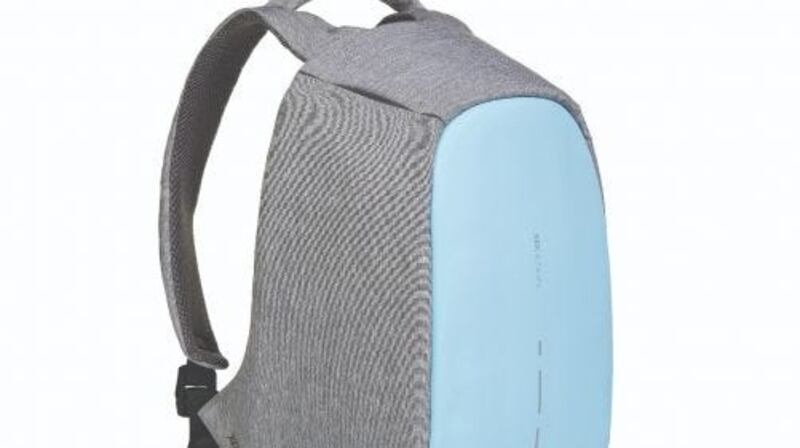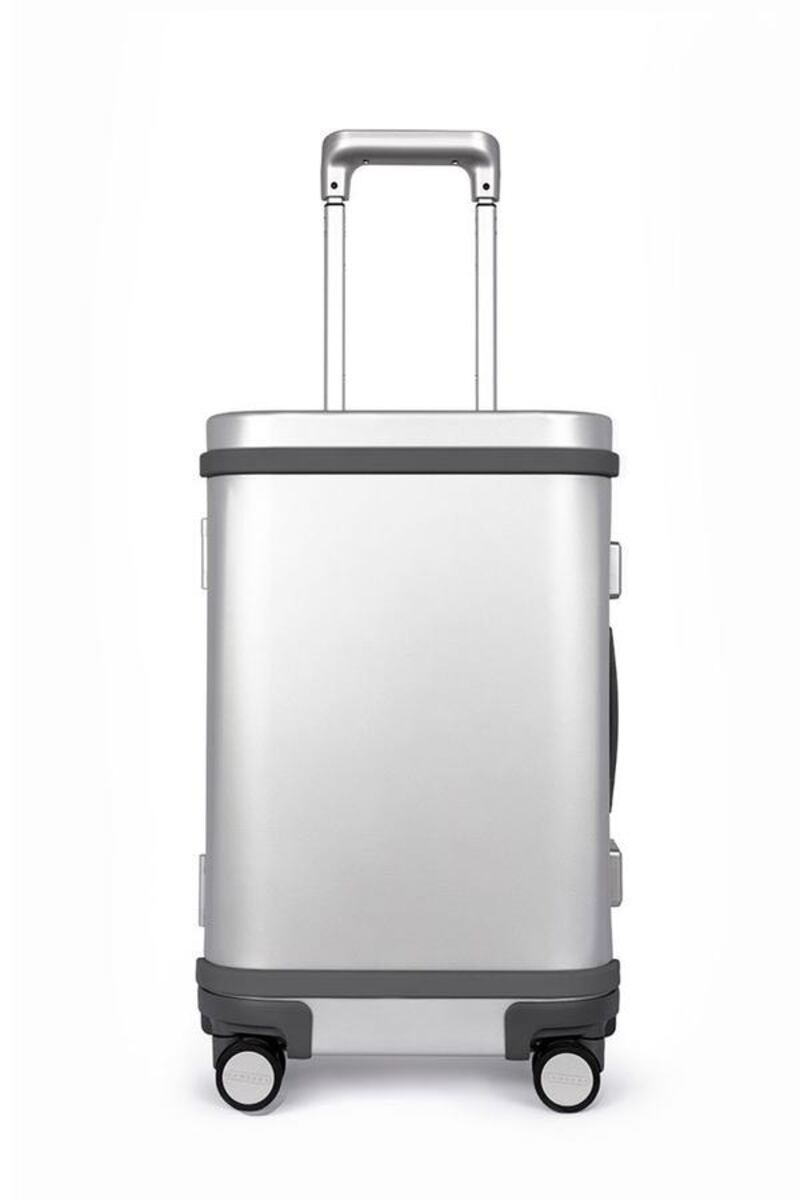How high tech is your travel? From noise-cancelling headphones and high-tech bag trackers to smart luggage that follows you around the airport, there are plenty of ways to make your travel a little more interesting – and pleasant.

Bags
The daily commuter has very different needs from a long haul traveller when it comes to baggage. Occasionally though, they can cross over. For example XD Design’s Bobby Compact bag (€95) can work as a regular daily travel bag and an aeroplane carry on.
The bag has hidden zips to keep your kit away from prying hands, is cut resistant and an integrated USB charging port. If you are a commuter, you’ll be pleased to know it has water repellent fabric and an integrated rain cover – especially important for cyclists, given the recent storm weather – and illuminating safety strips. There is a luggage strap too, and shock-proof compartments for your electronics, so when the bag inevitably falls off your suitcase, your tablet or laptop might stand a chance of coming out with the screen intact.
If you want something a little closer to home, Irish company Juku has a backpack that plugs into your own rechargeable battery pack inside, giving you integrated power. It also has the hidden zips and pockets, is water resistant and has a luggage strap to fix it to your suitcase handle. It's also slightly cheaper at €89.
Smart bags
Then there are the carry-on bags that pack everything from GPS to an extra battery pack in their slim, hardshell frames. For €245, you can get the Carry-on by Away, a small suitcase that has everything from a hidden laundry bag to an ejectable battery for charging your smartphone. It doesn’t do a whole lot else though. For some extra investment, you can get the Samsara carry-on bag, which not only charges your phone but also has a flat top so you can use it as a work surface in the airport, interior LED lights and a smartphone app that will track your case when it is out of your sight.

Pulling your own suitcase along through an airport is not usually one of life’s greatest hardships. Not enough to justify spending money on a robotic suitcase that drives itself, at least. But throw in some extra luggage to handle or some mobility issues and the idea of a suitcase that shifts itself isn’t as unnecessary as it may have seemed. That’s where Forward X comes in with its Ovis suitcase.
Is that convenience worth €718 though? Maybe. The Ovis suitcase is carry-on size and uses computer vision, sensors and facial recognition to follow you, staying by your side as you rush to make your flight. You get a range of about 19km on a single charge, plus it has a GPS tag so you can track it if your case goes missing.
Regardless of what brand of smart luggage you choose though, make sure the battery pack can be easily removed. If you have to check your bag, airlines will insist that the battery is taken out and carried on board the aircraft; the last thing you need just as you are boarding the flight is to be wrestling with a rechargeable battery.
Bag trackers
You don't have to spend hundreds of euro on a single bag to get the ability to track your bags though. For short-range tracking, there is the Tile Mate or Tile Pro tags, which use Bluetooth and when needed can call on the power of its community of users to find your lost bag – assuming your chosen brand has a good network of users in that particular area. Long range, you can turn to Vodafone's V-Bag Tracker, which costs €80 plus the €3 per month fee for the Vodafone V-Sim to get data coverage. The slim tracker slips inside your bag, and when paired with the app, will give you a reasonably accurate idea of where your bag is. Getting it back, however, will be down to you.
The advantage of the trackers are that they can be easily switched to another bag, so they are far more flexible. Plus the trackers themselves are reasonably priced.

Travel pillows
Does anyone ever get a decent rest on a plane? I don’t know a single person who has emerged from a long-haul flight feeling well rested. OstrichPillow decided to tackle the issue of sleep – and helping us improve it, even while on the move – with its new range of travel pillows. They are designed for use on your commute (the OstrichPillow Light) or at your desk (the OstrichPillow mini). But it was the original OstrichPillow that really grabbed our attention. Designed to block out light and other people, it gives the wearer a somewhat Doctor Who alien appearance, cocooning your entire head in a comfy covering. And it costs €80. Added bonus: you look so strange that people automatically leave you alone.
Eye masks are a common sight on long-haul flights, especially if you turn left as you enter the plane. But not even first class will supply a mask that cuts out the background noise as well as the light. Firebox sells a Bluetooth mask that will play your music, podcast or other calming tracks while you relax. A full charge gets you about six hours of audio, and all without annoying your seatmate.
Getting from A to B
If you’ve been outdoors in the past few months, there’s a high chance that you’ve come very close to an electric scooter, whizzing its way down the road and propelling its rider at speeds of up to 35km/h. The new generation of electric scooters have a couple of things going for them: they are portable, so you can throw them in the boot of the car for that “last mile” trip; they are reasonably cheap compared with other modes of transport, with prices ranging from €300-€600 and more; and they can be easily recharged at home.
There are plenty of options out there. Seat has jumped on the micro-mobility bandwagon with the eXS KickScooter. Essentially a Segway scooter with a bit of Seat design, the eXs KickScooter will get you 25km on a single charge. It costs about €600, and has its own app that allows you to keep an eye on your range (not while driving, obviously) and lock the wheels to provide a small measure of theft protection.
Slightly cheaper is the Xiaomi M365, which ranges in price between €400 and €500 depending on where you shop, but will only get you 30km of range.
Irish roads though may need to catch up. Potholes and bad surfaces are no friend to the e-scooter rider, and that’s on the reasonably well kept roads.
The other drawback? They’re not legal on Irish roads yet, despite a Government review of the situation, because you can’t tax and insure them. That also goes for public paths by the way, just in case there was any ambiguity over it. But the rules are being applied somewhat inconsistently. Some people are having their scooters impounded, others can happily zoom around town with little comeback.
The upshot is if you are out on public roads, you may find your new mode of transport confiscated by the gardaí. Or you may not. You take your chances and deal with the consequences.

If you want to take it up a notch, you could look at a fully electric scooter. These are more like mopeds than the previously mentioned scooters, so should make you feel a bit safer on Irish city streets. The main difference is that they have a fully electric battery instead of a petrol engine.
The entry-level Niu U electric scooter gets up to 40km on a single charge and hits speeds of up to 45km/h, and will set you back €2,500 from Irish company Lion (elion.ie). Plus it is smartphone-app enabled, so you get real-time data from your scooter directly to your phone, from real-time GPS data to the anti-theft alert and alarm, plus real-time diagnostics.
If you need a bit more range, and have a bit more cash to spend, the Niu M+ gets you 100km from a single charge.
Cameras
Whether you are a cyclist or a motorist, an extra pair of eyes on the road isn’t a bad thing to have at your disposal. You may have noticed the number of dashcams that are displayed in the windscreens of cars has vastly increased in recent months, and when gardaí put out appeals for witnesses to a crash, it is usually accompanied by a plea for any dashcam footage that may have been captured in the area too.
For motorists, there are plenty of options. Nextbase has a range of dashcams on sale in Ireland that will keep a watchful eye on the road and automatically lock any potential crash footage to prevent you from accidentally deleting it. The current range includes the 522GW, which takes good quality footage and can include GPS data for each of the clips it takes. It's easy to set up too, and it includes the ability to integrate it with your Amazon Alexa smart assistant, should you be into that kind of thing. It comes in at around €190.
Cyclists need something a little more portable and battery friendly. You could mount a GoPro on your handlebars and record the road ahead, but what about the road behind you? The Cycliq Fly6 doubles as a rear light and a camera, recording as you ride. The footage is recorded in high definition at 60 frames per second, and if there is an incident, it automatically locks the video clip so you can turn it over to the relevant authorities. It won’t prevent accidents, but it may help hold those responsible to account. The light built into the Fly6 is 100 lumens, so you’ll definitely be seen even on dark roads. The generation 2 will cost you €199.





















